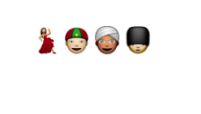There are 59 different types of food Emoji, but the pictorial smartphone language has been severely lacking in other areas—specifically when it comes to racial diversity.
To address the continuous stream of poop emojis being flung its way for not providing a single black emoji, developer Unicode announced a range of new skin tones Tuesday that will be available in its Unicode Version 8.0 launch in June 2015.
Here is a sampling of the new color options:
The coding indicates that any Emoji can be portrayed with a different skin tone:
“People all over the world want to have emoji that reflect more human diversity, especially for skin tone,” the organization’s report reads. “The Unicode emoji characters for people and body parts are meant to be generic, yet following the precedents set by the original Japanese carrier images, they are often shown with a light skin tone instead of a more generic (inhuman) appearance, such as a yellow/orange color or a silhouette.”
Unicode Version 8.0 is adding 5 symbol modifier characters that provide for a range of skin tones for human emoji. These characters are based on the six tones of the Fitzpatrick scale, a recognized standard for dermatology (there are many examples of this scale online, such as FitzpatrickSkinType.pdf). The exact shades may vary between implementations.
This marks a significant improvement upon the racial stereotypes exhibited previously in the Emoji’s original language:

Read next: President Obama Is Reaching Out to Millennials About the Economy Using…Emoji
More Must-Reads From TIME
- The 100 Most Influential People of 2024
- Coco Gauff Is Playing for Herself Now
- Scenes From Pro-Palestinian Encampments Across U.S. Universities
- 6 Compliments That Land Every Time
- If You're Dating Right Now , You're Brave: Column
- The AI That Could Heal a Divided Internet
- Fallout Is a Brilliant Model for the Future of Video Game Adaptations
- Want Weekly Recs on What to Watch, Read, and More? Sign Up for Worth Your Time
Contact us at letters@time.com